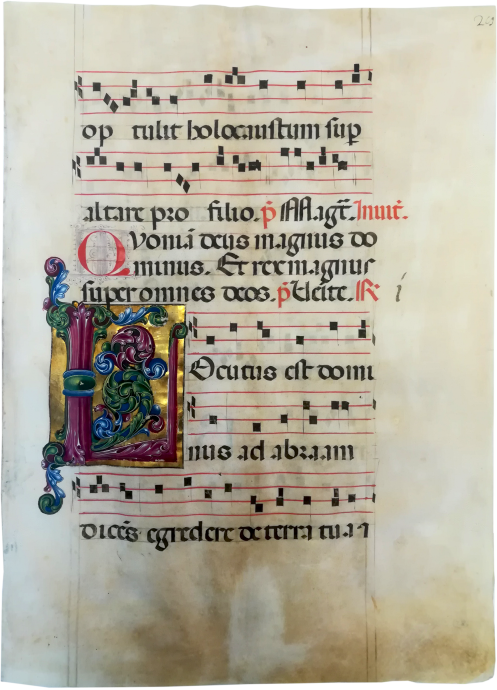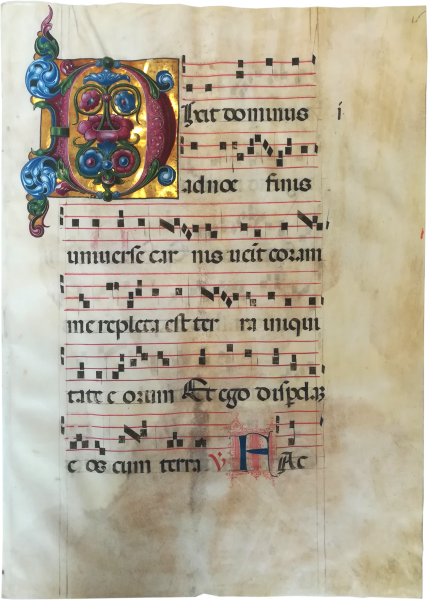


Northern Italian Illuminator
, c. 1470sNorthern Italian Illuminator
Description
This leaf bears a tall illuminated initial 'L' with burnished gold and vivid colors. The initial opens the chant Locutus est dominus ad Abraam ("The Lord spoke to Abraham"), first response of the first nocturn of Matins for Quinquagesima Sunday. The initial 'L' with a tall ascender is painted in magenta and highlighted in white with column-like fluting and foliates, the inside with tightly-wound swirls of foliates painted in boldly contrasting colors and highlighted with distinctive white hatches. Additional foliates loop spray into the margins.
The leaf comes from an Antiphonal that contained music for the Temporale (or Proper of Time), the portion of the liturgical year leading up to Easter. The bold style of the decoration best compares to initials in Choir Books illuminated by Ferrarese artists in the circle of Martino da Modena in the 1470s. These initials are characterized by tightly-wound and copiously highlighted swirls of foliates in blue, green, and magenta. The style of the decoration can also be compared to initials and borders in the Choir Books of Cardinal Bessarion, painted by illuminators working in Ferrara in the decades around 1460, including Franco dei Russi and Guglielmo Giraldi, who also worked on Bibles and Missals made for Borso d'Este and Ercole I d'Este (Palladino, pp. 78-96).
The leaf ruled in ink with five (recto) or six (verso) registers of square notation on four-line staves in red (rastrum 32 mm.), rubrics in red, and initials in blue and red with purple and red penwork decorations, written in brown ink in a Gothic rotunda, with the fragment of a preceding chant ending "sup(er) altare pro filio," rubrics and text for the invitatory Quoniam deus magnus, and the chants Locutus est dominus ad Abraam (recto/verso), and Benedicens benedicam, the later ending imperfectly with "...magnificabo," with Roman numeral "i" in the right margin of the recto (numbering the response), and with a later foliation in the top corner of the recto, "28," and also numbered and circled in lower corner, "28." The miniature with minor losses of pigment in places, otherwise in good condition, the leaf with some minor cockling, the lower corner folded over, and with some pigment transfer to the left edge of the recto side.
Literature:
For comparisons see:
Palladino, P. Treasures of a Lost Art: Italian Manuscript Painting of the Middle Ages and Renaissance, New York, 2003, pp. 78-96 [exhibition catalogue].
Alexander, J. J. G. The Painted Book in Renaissance Italy, 1450-1600, New Haven and London, 2016, pp. 83-90, esp. p. 87.
